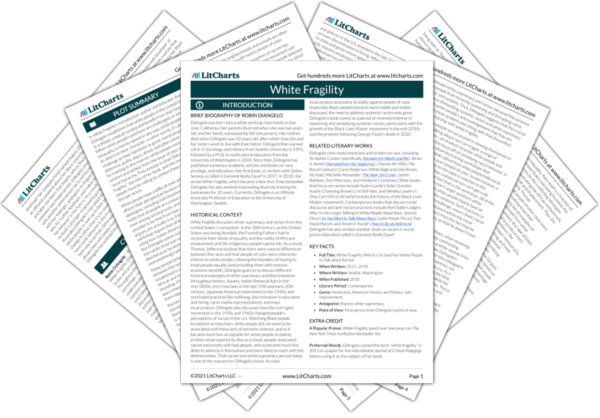Summary
Analysis
DiAngelo has discovered a set of unspoken rules for how to give white people feedback about racism. The first rule is not to give any feedback about racism under any circumstances. But if that rule must be broken, people must follow other rules: proper tone is crucial, there must be trust between the person giving feedback and the person receiving it, feedback must be given immediately and privately, and white people must feel completely safe and comfortable. The function of these rules is to obscure and deflect from racism and maintain white dominance.
This list of unspoken rules again emphasizes how sensitive white fragility makes white people. In all of these cases, it makes the feedback more about how the message is presented rather than what the message is, allowing white people to focus in on things like an angry tone or a public shaming as ways in which they are victimized, so that they don’t have to address racist behavior.
Themes
When receiving feedback, DiAngelo tries to follow two guidelines: first, how, when, and where a person gives her feedback is irrelevant, and it’s on her to build her racial stamina to accept it. The second guideline is to thank the person. These guidelines acknowledge that white people have blind spots and that they are responsible for interrupting racism; thus, they must be grateful when others help them achieve that goal.
White fragility is evident in the fact that white people need to build trust before they can explore racism in workshops so that others don’t think they are racist. They don’t want to be judged, they want people to assume they have good intentions, and they want to be respected. But once again, this prioritizes white people’s feelings over those who feel the impact of racism.
This passage suggests that white people are more invested in not appearing racist than actively working to change any racist behavior they might exhibit—when the efforts should be the opposite.
Themes
White people raised in Western society are conditioned into a white supremacist worldview, and it is important to understand this so that white people can focus on how—not if—they perpetuate racism. And, DiAngelo adds, stopping racist patterns must be more important than convincing other people that they don’t have them.
This passage returns to the idea that white supremacy is deeply ingrained in Western society, so no one is exempt from racism. Therefore, trying to convince others that white people have no racist behavior is pointless. The important thing is to acknowledge this behavior and work to change it.
Themes
Get the entire White Fragility LitChart as a printable PDF.













